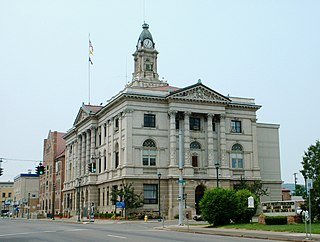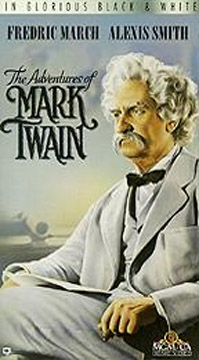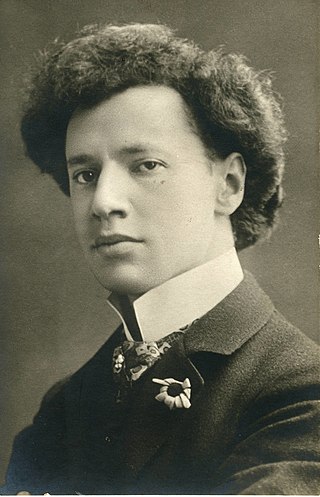Related Research Articles

Samuel Langhorne Clemens, known by the pen name Mark Twain, was an American writer, humorist, and essayist. He was praised as the "greatest humorist the United States has produced," with William Faulkner calling him "the father of American literature." Twain's novels include The Adventures of Tom Sawyer (1876) and its sequel, Adventures of Huckleberry Finn (1884), with the latter often called the "Great American Novel." He also wrote A Connecticut Yankee in King Arthur's Court (1889) and Pudd'nhead Wilson (1894), and co-wrote The Gilded Age: A Tale of Today (1873) with Charles Dudley Warner.

Elmira is a city in and the county seat of Chemung County, New York, United States. It is the principal city of the Elmira, New York, metropolitan statistical area, which encompasses Chemung County. The population was 26,523 at the 2020 census, down from 29,200 at the 2010 census, a decline of more than 7 percent.

Metro-North Railroad, trading as MTA Metro-North Railroad, is a suburban commuter rail service operated by the Metropolitan Transportation Authority (MTA), a public authority of the U.S. state of New York. Metro-North serves the New York Metropolitan Area, running service between New York City and its northern suburbs in New York and Connecticut, including Port Jervis, Spring Valley, Poughkeepsie, Yonkers, New Rochelle, Mount Vernon, White Plains, Southeast and Wassaic in New York and Stamford, New Canaan, Danbury, Bridgeport, Waterbury, and New Haven in Connecticut. Service in Connecticut is operated under contract with the Connecticut Department of Transportation. Metro-North also provides local rail service within the New York City boroughs of Manhattan and the Bronx.

Elmira College is a private college in Elmira, New York. Founded as a college for women in 1855, it is the oldest existing college granting degrees to women that were the equivalent of those given to men. Elmira College became coeducational in all of its programs in 1969. As of 2023, the college has an enrollment of approximately 657 students.

The Erie Lackawanna Railway, known as the Erie Lackawanna Railroad until 1968, was formed from the 1960 merger of the Erie Railroad and the Delaware, Lackawanna & Western Railroad. The official motto of the line was "The Friendly Service Route".

CSX Corporation is an American holding company focused on rail transportation and real estate in North America, among other industries. The company was established in 1980 as part of the Chessie System and Seaboard Coast Line Industries merger. The various railroads of the former Chessie System and Seaboard Coast Line Industries that are now owned by CSX Corporation were eventually merged into a single line in 1986 and it became known as CSX Transportation. CSX Corporation currently has a number of subsidiaries beyond CSX Transportation. Previously based in Richmond, Virginia after the merger, the corporation moved its headquarters to Jacksonville, Florida, in 2003. CSX is a Fortune 500 company.

The Adventures of Mark Twain is a 1944 American biographical film directed by Irving Rapper and starring Fredric March as Samuel Clemens and Alexis Smith as Twain's wife Olivia. Produced by Warner Bros., the film was nominated for three Academy Awards, including that for Best Music for Max Steiner's score. Irving Rapper was hesitant to direct the film but was persuaded by Hal B. Wallis.

Woodlawn Cemetery is the name of a cemetery in Elmira, New York, United States. Its most famous burials are Mark Twain and his wife Olivia Langdon Clemens. Many members of the United States Congress, including Jacob Sloat Fassett are also interred there.

Ossip Salomonovich Gabrilowitsch was a Russian-born American pianist, conductor and composer.

Jane Lampton "Jean" Clemens was the daughter of Samuel Langhorne Clemens and Olivia Langdon Clemens. She founded or worked with a number of societies for the protection of animals.

Olivia Langdon Clemens was the wife of the American author Samuel Langhorne Clemens, better known under his pen name Mark Twain.
Mark Twain: The Musical is a stage musical biography of Mark Twain that had a ten-year summertime run in Elmira, NY and Hartford, CT (1987–1995) and was telecast on a number of public television stations. An original cast CD was released by Premier Recordings in 1988, and LML Music in 2009 issued a newly mastered and complete version of the score. Video and DVD versions of the show are currently in release.

Olivia Susan Clemens was the second child and eldest daughter of Samuel Clemens, who wrote under the pen name Mark Twain, and his wife Olivia Langdon Clemens. She inspired some of her father's works, at 13 wrote her own biography of him, which he later published in his autobiography, and acted as a literary critic. Her father was heartbroken when she died of spinal meningitis at age 24.

Clara Langhorne Clemens Samossoud, was an American concert singer, and the daughter of Samuel Clemens, who wrote as Mark Twain. She managed his estate and guarded his legacy after his death as his only surviving child. She was married first to Ossip Gabrilowitsch, then to Jacques Samossoud after Gabrilowitsch's death. She wrote biographies of Gabrilowitsch and of her father. In her later life, she became a Christian Scientist.

Alfred Edward Perlman was a railroad executive, having served as president of the Penn Central Transportation Company and its predecessor, the New York Central Railroad, and later, president of the Western Pacific railroad presiding over its successful turnaround before being absorbed into the present day Union Pacific system.

Quarry Farm is located on East Hill overlooking Elmira, New York, and the Chemung River Valley. In 1869, Jervis Langdon purchased the property as a vacation home for his family. When he died the following year, it was inherited by his eldest daughter, Susan Langdon Crane. It remained in the Langdon family until 1982, when it was donated to Elmira College as part of the founding of the Center For Mark Twain Studies.
James Miller Symes, was the 13th president of the Pennsylvania Railroad.
Herbert Hawley Harwood Jr. is an American author. He has published many books, all of which are on the subject of railroad history.
The Center For Mark Twain Studies is a cultural humanities site associated with Elmira College. The Center manages two historic sites, the Octagonal Study and Quarry Farm, where the American author, Mark Twain, composed many of his works, including his 1884 novel Adventures of Huckleberry Finn. The center also includes exhibits and archives. It administers research fellowships and delivers extensive programming, including lectures series, symposia, teachers institutes, digital resources, podcasts, and the quadrennial International Conference on the State of Mark Twain Studies.
H. Roger Grant was an American railroad historian and author. He died on November 17, 2023, at the age of 79.
References
- ↑ "Jervis Langdon Jr., 99, Dies; Rail Executive Led Penn Central". The New York Times . Retrieved 2020-09-06.
- ↑ H. Roger Grant (2008). Visionary Railroader: Jervis Langdon Jr. and the Transportation Revolution. Indiana University Press. ISBN 9780253352163 . Retrieved 2017-04-27.
- ↑ Wilson, Larry (February 20, 2004). "'A true gentleman' recalled: Jervis Langdon Jr., grandnephew of Mark Twain, dies". Elmira Star-Gazette. Retrieved 2022-04-30.